Blog

Dynamics 365 2021 Release Wave 2 Dataverse Search
Did you know there are global search enhancements included in the Microsoft’s Dynamics 365 Wave 2 release known as Dataverse search? These powerful Dataverse search features will change the way users filter and search for records in model-driven Power Apps.
What is Dataverse Search?
Microsoft Dataverse search is a robust tool used for easily querying records across multiple entities with a few clicks and keystrokes. The search box is available in the header of every page in model-driven apps and can be configured to fit your organization’s needs within the Microsoft Power Platform admin center.
How to Enable and Configure Dataverse Search
Enable Dataverse search in the Power Platform admin center within a selected environment’s settings.
Once enabled, users can select the tables (or entities) and search indexes they want for a solution within the Power Apps portal.
When users select tables for indexing, they are provided with the number of columns (or fields) that are included in Dataverse search. The number of indexed columns are dependent on the table’s quick find view. Although there is not a limit to the number of tables users can index, there is a limit on the number of searchable fields that can be configured for indexing, which is 950 per organization. Also, some types of fields count as more than 1 searchable field. For example, a single lookup field counts as 3 searchable fields, a single option set counts as 2 searchable fields, and all other fields types count as 1 searchable field. Users can adjust which searchable fields are included in Dataverse search within the Power Apps portal.
Intelligent Searching, Matching, and Filtering
When using Dataverse search, the system will offer suggested results based on the terms entered in the search box. And before users begin typing terms, Dataverse will display the user’s last 3 searches and recently viewed records grouped by table type. Search results are broken down into different tabs based on relevance. The first tab displayed returns the top 20 results related to the search term. Following the top results tab are table-specific tabs that return all matches on the search term ordered by relevance.
When users click into table-specific tabs, they can apply additional filters to their search results using different facets. System Administrators can configure default facets in using the tables’ quick find view. However, users can set their own facets in their personalization settings. In addition to configurable facets, there are 3 global facets available on each search result tab, which are Owner, Modified On, and Created On.
Advanced Search Operators
Dataverse search allows for the ability to use 3 types of boolean operators when searching for records. Users can search a combination of terms using the ( + ) operator, which initiates an “And” search. For example, “Beringer + John”, will return all records containing Beringer and John. Users can also use a combination of terms using the ( | ) operator, which initiates an “Or” search. For example, “Beringer | John”, will return any record that contains Beringer or John. Lastly, users can exclude a combination of terms using the ( – ) operator, which initiates a “Not” search. For example, “Beringer + -John”, will return records containing Beringer but exclude records containing John.
Reach out to Beringer today!
Does your organization need tips for configuring and using the new Dataverse search in Dynamics 365? At Beringer, we love to implement Microsoft Dynamics 365 solutions and related technologies. We’ve been working with Microsoft Dynamics since its inception, and we’re always finding innovative ways to implement the latest tools and help automate business processes.
Beringer Technology Group, a leading Microsoft Gold Certified Partner specializing in Microsoft Dynamics 365 and CRM for Distribution also provides expert Managed IT Services, Backup and Disaster Recovery, Cloud Based Computing, Email Security Implementation and Training, Unified Communication Solutions, and Cybersecurity Risk Assessment.







